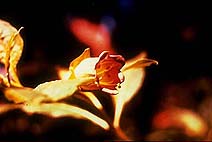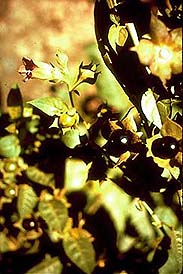Belladonna, Deadly nightshade
Atropa belladonna The generic name of this plant was given by the famous Swedish botanist Carl Linnaeus after one of the three ancient Greek goddesses of life, Atropa, the one who was believed to cut the thread of life. |
The name of the species comes from Latin and means a âpretty womanâ. The reason was that, in the past, women used to treat their faces with belladonna. As a result, their cheeks turned red and a peculiar brightness appeared in their eyes. However, belladonna is deadly poisonous. This fact has been well known since ancient times. The tincture of belladonna leaves used to be one of the most popular poisons among professionals. It was believed that the famous Roman poisoner Locusta killed the Roman emperor Claudius with her deadly weaponâa tincture of belladonna. She was imprisoned and sentenced to death in 68 AD for having committed this crime. According to some legends, Scottish warriors succeeded in defending their country from Danish conquerors leaving them a special bootyâbarrels of beer poisoned with sap of belladonna. Another story tells about ancient Gaelic tribes that used belladonna before a battleâas a âherb of courageâ that stimulated them to fly into a rage.
Belladonna is a widespread herb. It grows in wet places in South and Central Europe, South America, West Asia and the Middle East. The first botanical description of the plant was made by Leonard Fuchs in his scientific treatise, published in 1500 in Strasbourg. |
|
Belladonna is a perennial plant that has oval dark-green leaves, bell-shaped violet blossoms and black cherry-like fruit. The latter is particularly attractive, especially to children, who happen to be the usual victims of this dangerous herb. The symptoms of poisoning appear quickly: dizziness, dry mouth, flush, nausea and vomiting, visual impairment, increased heart frequency, agitation and raving, followed by weakness and sleepiness, breathing compression and death. These toxic effects of belladonna are due to the high content of the alkaloids such as atropine (the most important one), scopolamine, hyoscyamine, and belladonnine in all parts of the plant.Medical application of belladonna began in the remote past. The famous Roman physician Galenus Claudius (129-201) described in his treatises the curative effects of the herb in cases of âterrible and unhealing ulcersâ. In the Middle Ages, despite the great respect for belladonna people had, physicians avoided to prescribe it because of their fear from its strong toxicity. Nowadays, belladonna is still in use due to its valuable alkaloid atropine, extracted from the roots of the plant. Atropine is a useful drug in different fields of medicine such as toxicology, ophthalmology, gastroenterology (as a painkiller), etc.


